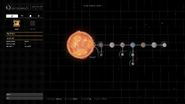Trappist-1 is an uninhabited system in the Core Systems within the Inner Orion Spur. The system is 42.36 ly away from Sol. In the early 21st century, human astronomers discovered seven terrestrial exoplanets in Trappist-1, the most of any documented system at the time. Three of these exoplanets fell in the system's habitable zone, and one was determined to have the potential to be an Earth-like world. Despite the importance of this discovery, Trappist-1 was never colonised and remains completely uninhabited in the 34th century.
System Layout[]
- Trappist-1 (Class M star)
- Trappist-1 1 (High metal content world)
- Trappist-1 1 a (High metal content world)
- Trappist-1 2 (Rocky body)
- Trappist-1 3 (High metal content world)
- Trappist-1 3 a (Rocky body)
- Trappist-1 4 (Earth-like world)
- Trappist-1 4 a (Rocky body)
- Trappist-1 4 b (Rocky body)
- Trappist-1 5 (High metal content world)
- Trappist-1 6 (High metal content world)
- Trappist-1 7 (Icy body)
- Trappist-1 1 (High metal content world)
Impact of Discovery on Elite Dangerous[]
Prior of the announcement of the discovery of TRAPPIST-1 on February 22, 2017, the Stellar Forge in Elite Dangerous had coincidentally generated a system with similar characteristics in nearly the same location: Core Sys Sector XU-P A5-0. In Elite Dangerous: Horizons 2.3, Frontier Developments updated the in-game system to have the same characteristics as the real system, and also renamed it to "Trappist-1".
The recent announcement of the discovery of the Trappist 1 system is exciting. The star, an M8 dwarf red star is right at the bottom end of the M class stars, so faint it is only just visible in the most powerful telescopes, and doesn’t feature in most star catalogues for this reason. Luckily, though, the system is almost exactly ‘edge on’ from our viewpoint – which means it is possible to ‘see’ the planets as they occlude the tiny star, and an incredible seven terrestrial planets have been spotted around the star by this technique, three of them in the ‘habitable zone’.
Even with Hubble, the fainter M class red stars are only just visible at 40 light years, which is why Trappist 1 is not in most of the star catalogues. Beyond this distance we can see ever fewer M class stars – particularly the fainter ones like this M8 – and it is where our procedural generation begins to kick in – supplementing the brighter, more visible stars.
The way Stellar Forge works is to use ‘available mass’ from which to generate systems – and because of this unaccounted mass, Stellar Forge has created a system with a Brown Dwarf in very nearly the same place – 39 light years away – this is only a little smaller than an M8 – and it even has seven terrestrial worlds around it – Core Sys Sector XU-P A5-0.
Interestingly the system that came out of Stellar Forge has a couple of moons, and a couple of co-orbiting binary pairs – these things would not (yet) be detected in the occlusion technique, as this is simply detecting the darkening of the stellar disc, but who knows, this might be possible.
Because of this we have tweaked Stellar Forge with the data from the recent discoveries so that the planets are now the same – and we have renamed it Trappist 1 – but the great thing is it is only a small tweak! We may still add a few moons back in, and this should go live in beta 2, and will of course be in 2.3 when it goes live to everyone.— David Braben commenting on the discovery of Trappist-1 and its impact on Elite Dangerous[1]
| Missing information
Can we get the old "Core Sys Sector XU-P A5-0" data here for comparison? The most interesting number is main star mass (planets are too chaotic to guess accurately, expect for their elemental composition). EDDB used to have it, but the site is gone. |








